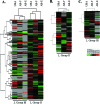Community genomic and proteomic analyses of chemoautotrophic iron-oxidizing "Leptospirillum rubarum" (Group II) and "Leptospirillum ferrodiazotrophum" (Group III) bacteria in acid mine drainage biofilms
- PMID: 19429552
- PMCID: PMC2704813
- DOI: 10.1128/AEM.02943-08
Community genomic and proteomic analyses of chemoautotrophic iron-oxidizing "Leptospirillum rubarum" (Group II) and "Leptospirillum ferrodiazotrophum" (Group III) bacteria in acid mine drainage biofilms
Abstract
We analyzed near-complete population (composite) genomic sequences for coexisting acidophilic iron-oxidizing Leptospirillum group II and III bacteria (phylum Nitrospirae) and an extrachromosomal plasmid from a Richmond Mine, Iron Mountain, CA, acid mine drainage biofilm. Community proteomic analysis of the genomically characterized sample and two other biofilms identified 64.6% and 44.9% of the predicted proteins of Leptospirillum groups II and III, respectively, and 20% of the predicted plasmid proteins. The bacteria share 92% 16S rRNA gene sequence identity and >60% of their genes, including integrated plasmid-like regions. The extrachromosomal plasmid carries conjugation genes with detectable sequence similarity to genes in the integrated conjugative plasmid, but only those on the extrachromosomal element were identified by proteomics. Both bacterial groups have genes for community-essential functions, including carbon fixation and biosynthesis of vitamins, fatty acids, and biopolymers (including cellulose); proteomic analyses reveal these activities. Both Leptospirillum types have multiple pathways for osmotic protection. Although both are motile, signal transduction and methyl-accepting chemotaxis proteins are more abundant in Leptospirillum group III, consistent with its distribution in gradients within biofilms. Interestingly, Leptospirillum group II uses a methyl-dependent and Leptospirillum group III a methyl-independent response pathway. Although only Leptospirillum group III can fix nitrogen, these proteins were not identified by proteomics. The abundances of core proteins are similar in all communities, but the abundance levels of unique and shared proteins of unknown function vary. Some proteins unique to one organism were highly expressed and may be key to the functional and ecological differentiation of Leptospirillum groups II and III.
Figures









Similar articles
-
New group in the Leptospirillum clade: cultivation-independent community genomics, proteomics, and transcriptomics of the new species "Leptospirillum group IV UBA BS".Appl Environ Microbiol. 2013 Sep;79(17):5384-93. doi: 10.1128/AEM.00202-13. Epub 2013 May 3. Appl Environ Microbiol. 2013. PMID: 23645189 Free PMC article.
-
Genome-directed isolation of the key nitrogen fixer Leptospirillum ferrodiazotrophum sp. nov. from an acidophilic microbial community.Appl Environ Microbiol. 2005 Oct;71(10):6319-24. doi: 10.1128/AEM.71.10.6319-6324.2005. Appl Environ Microbiol. 2005. PMID: 16204553 Free PMC article.
-
Multi-omics Reveals the Lifestyle of the Acidophilic, Mineral-Oxidizing Model Species Leptospirillum ferriphilumT.Appl Environ Microbiol. 2018 Jan 17;84(3):e02091-17. doi: 10.1128/AEM.02091-17. Print 2018 Feb 1. Appl Environ Microbiol. 2018. PMID: 29150517 Free PMC article.
-
Quantitative proteomic analyses of the response of acidophilic microbial communities to different pH conditions.ISME J. 2011 Jul;5(7):1152-61. doi: 10.1038/ismej.2010.200. Epub 2011 Jan 13. ISME J. 2011. PMID: 21228889 Free PMC article.
-
Microbial Ecology and Evolution in the Acid Mine Drainage Model System.Trends Microbiol. 2016 Jul;24(7):581-593. doi: 10.1016/j.tim.2016.03.004. Epub 2016 Apr 2. Trends Microbiol. 2016. PMID: 27050827 Review.
Cited by
-
A Nitrospira metagenome illuminates the physiology and evolution of globally important nitrite-oxidizing bacteria.Proc Natl Acad Sci U S A. 2010 Jul 27;107(30):13479-84. doi: 10.1073/pnas.1003860107. Epub 2010 Jul 12. Proc Natl Acad Sci U S A. 2010. PMID: 20624973 Free PMC article.
-
Mechanisms of bioleaching: iron and sulfur oxidation by acidophilic microorganisms.Essays Biochem. 2023 Aug 11;67(4):685-699. doi: 10.1042/EBC20220257. Essays Biochem. 2023. PMID: 37449416 Free PMC article. Review.
-
GeoChip-based analysis of the functional gene diversity and metabolic potential of microbial communities in acid mine drainage.Appl Environ Microbiol. 2011 Feb;77(3):991-9. doi: 10.1128/AEM.01798-10. Epub 2010 Nov 19. Appl Environ Microbiol. 2011. PMID: 21097602 Free PMC article.
-
Metagenomic analyses: past and future trends.Appl Environ Microbiol. 2011 Feb;77(4):1153-61. doi: 10.1128/AEM.02345-10. Epub 2010 Dec 17. Appl Environ Microbiol. 2011. PMID: 21169428 Free PMC article. Review.
-
Unraveling interactions in microbial communities - from co-cultures to microbiomes.J Microbiol. 2015 May;53(5):295-305. doi: 10.1007/s12275-015-5060-1. Epub 2015 May 3. J Microbiol. 2015. PMID: 25935300 Review.
References
-
- Aguilar, P. S., and D. de Mendoza. 2006. Control of fatty acid desaturation: a mechanism conserved from bacteria to humans. Mol. Microbiol. 62:1507-1514. - PubMed
-
- Altschul, S. F., W. Gish, W. Miller, E. W. Myers, and D. J. Lipman. 1990. Basic local alignment search tool. J. Mol. Biol. 215:403-410. - PubMed
-
- Andersson, A. F., and J. F. Banfield. 2008. Virus population dynamics and acquired virus resistance in natural microbial communities. Science 320:1047-1050. - PubMed
-
- Aoshima, M., and Y. Igarashi. 2006. A novel oxalosuccinate-forming enzyme involved in the reductive carboxylation of 2-oxoglutarate in Hydrogenobacter thermophilus TK-6. Mol. Microbiol. 62:748-759. - PubMed
Publication types
MeSH terms
Substances
Associated data
- Actions
- Actions
LinkOut - more resources
Full Text Sources
Molecular Biology Databases

